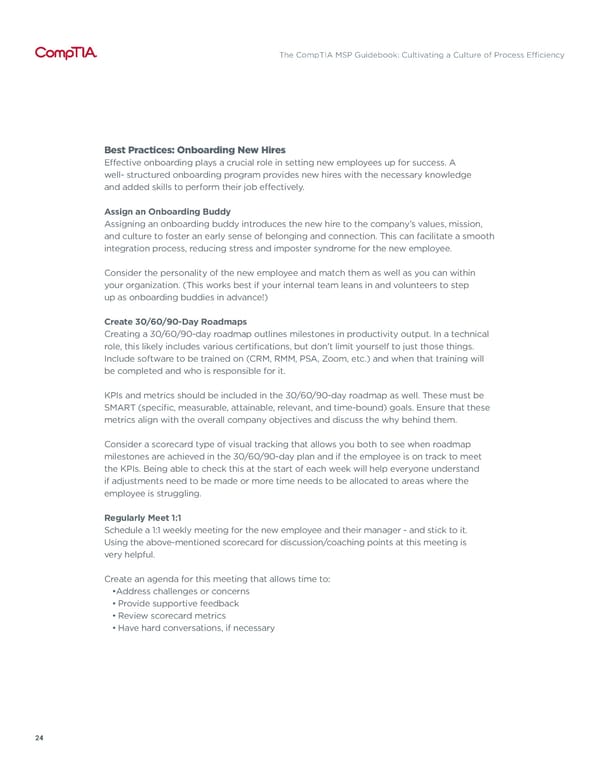The CompTIA MSP Guidebook: Cultivating a Culture of Process E昀케ciency Best Practices: Onboarding New Hires E昀昀ective onboarding plays a crucial role in setting new employees up for success. A well- structured onboarding program provides new hires with the necessary knowledge and added skills to perform their job e昀昀ectively. Assign an Onboarding Buddy Assigning an onboarding buddy introduces the new hire to the company’s values, mission, and culture to foster an early sense of belonging and connection. This can facilitate a smooth integration process, reducing stress and imposter syndrome for the new employee. Consider the personality of the new employee and match them as well as you can within your organization. (This works best if your internal team leans in and volunteers to step up as onboarding buddies in advance!) Create 30/60/90-Day Roadmaps Creating a 30/60/90-day roadmap outlines milestones in productivity output. In a technical role, this likely includes various certi昀椀cations, but don’t limit yourself to just those things. Include software to be trained on (CRM, RMM, PSA, Zoom, etc.) and when that training will be completed and who is responsible for it. KPIs and metrics should be included in the 30/60/90-day roadmap as well. These must be SMART (speci昀椀c, measurable, attainable, relevant, and time-bound) goals. Ensure that these metrics align with the overall company objectives and discuss the why behind them. Consider a scorecard type of visual tracking that allows you both to see when roadmap milestones are achieved in the 30/60/90-day plan and if the employee is on track to meet the KPIs. Being able to check this at the start of each week will help everyone understand if adjustments need to be made or more time needs to be allocated to areas where the employee is struggling. Regularly Meet 1:1 Schedule a 1:1 weekly meeting for the new employee and their manager - and stick to it. Using the above-mentioned scorecard for discussion/coaching points at this meeting is very helpful. Create an agenda for this meeting that allows time to: •Address challenges or concerns • Provide supportive feedback • Review scorecard metrics • Have hard conversations, if necessary 24
 CompTIA MSP Guidebook Page 23 Page 25
CompTIA MSP Guidebook Page 23 Page 25